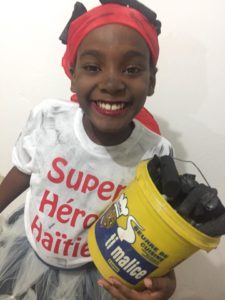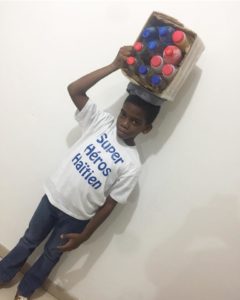This post is also available in: Kreyol
My two kids and I always have a lot of fun planning costumes for their school carnival celebrations every year. This year, the conversation started one day while we were driving, and my son and daughter already had a list of costume ideas in mind. All of their costume ideas were either superheroes from cartoons or Disney characters. But I had something different in mind. I told them that this year we would not do imported costumes.
I told them that this year we would not do imported costumes.
I told them Kanaval is different from Halloween. We moved to Haiti from Florida several years ago, but there are still certain cultural things I need to clarify for them from time to time. During Kanaval, I explained, we’re supposed to do something local that represents something in Haitian culture or Haitian history.
 At first, they protested, “There are no cool Haitian personalities, heroes, or characters we can dress up as.” I told them I guess we have to find some. I decided to make an activity out of it where we would look around at the people we cross every day, and find our heroes. Dimitri jokingly said, “well, the only people around us are machann papita and fruit vendors,” and he was laughing about it. I asked why that was funny. These are hardworking people, and in a sense, these are our Haitian heroes. This led us to having a real conversation about what heroes are, who are the heroes in our lives, and what the word really means.
At first, they protested, “There are no cool Haitian personalities, heroes, or characters we can dress up as.” I told them I guess we have to find some. I decided to make an activity out of it where we would look around at the people we cross every day, and find our heroes. Dimitri jokingly said, “well, the only people around us are machann papita and fruit vendors,” and he was laughing about it. I asked why that was funny. These are hardworking people, and in a sense, these are our Haitian heroes. This led us to having a real conversation about what heroes are, who are the heroes in our lives, and what the word really means.
This task was not easy. The kids protested, they said “No! I don’t want to be a machann!” There were even tears! I urged them to simply go through the process with me. We decided to start by simply identifying people they could possibly dress up as. I asked them to focus on people who wake up every day and spend hours under the sun, going up and down the street, trying to make a living. So, that became our focus. They each went off to compile a list of who they thought fit that description.
Dimitri’s list consisted of: Pappadap guy (Digicel card vendors), chany (shoe shiner), machann papita. Alexa’s list had fruit vendors, machann chabon (charcoal vendor), laundry lady, and housekeeper. We had to keep it simple so they could be easily identifiable as costumes and easy to replicate. Once we looked at the lists, we decided on the machann chabon for Alexa, and juice vendor for Dimitri.
The next step was interviewing a few people. We interviewed a Pappadap guy and a juice vendor. They explained to us the work they do, and how the money they bring in from their sales is what allows them to pay their children’s school. The Pappadap guy explained that he uses the money he makes selling Digicel minutes to fund his other business. He was also able to save his profits to purchase a motorcycle that he uses to work as a messenger as another source of income. I actually use his messenger services sometimes, and I wanted the kids to see that he’s actually a really cool guy. Without his services, my personal business would not be able to run as smoothly. My father recently passed away, and leading up to that, I have been away for long periods of time to take care of him. This man and his messenger services have been a godsend during this time.
What was most important for me was showing my children that there is honor in the careers that we are taught to look down on. We are so surrounded by people who are focused on trying to make money, they would do anything to get their hands on it. We fail to highlight the true role models. I wanted to show my children that these are the true heroes.
I also wanted to highlight the importance of hard work. You have to work to live, and these people are out here doing that day in and day out. We are not better than them because they do not work in an office, and because of the services and products they offer, our lives are so much better for it.
When I dropped them off at school that morning, they were way more excited about their local Haitian hero costumes than I was. Alexa had a headpiece on that I had attached pieces of charcoal to along with a can of charcoal in her hand. Right before leaving, I suggested she leave the can so she would not have too many things to carry throughout the day. She looked at me and said “Nope. I’m going in with my can of charcoal. Thanks!” And proudly walked into the school building, ready to rock her costume.
*Note: the machann chabon costume choice has raised some questions about whether this sends a negative message about protecting the environment. These are good questions, and while the charcoal industry has long been blamed for Haiti’s deforestation problem, researchers are starting to rethink this narrative. We urge you to check out a few good articles on the topic:
One of the most repeated facts about Haiti is a lie: Vice.com
Le charbon de bois cause-t-il vraiment le déboisement en Haïti? : Ayibopost.com
